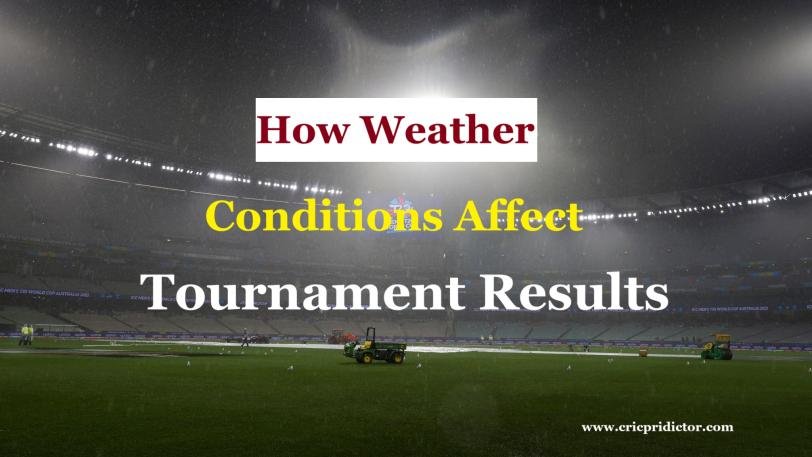How Weather Conditions Affect Tournament Results

Cricket is a game of skill, strategy, and adaptability, but one factor that remains beyond a team’s control is the weather. From rain interruptions to extreme heat, weather conditions can significantly impact match results, player performances, and even tournament outcomes. This will be especially crucial in the ICC Champions Trophy 2025, where unpredictable conditions could shape the fate of teams. Understanding these effects can help cricket enthusiasts, bettors, and analysts make more accurate Cricket Betting Sites and refine their Match predictions strategies.
Impact of Weather Conditions on Cricket Matches
1. Rain and Duckworth-Lewis-Stern (DLS) Method
Rain is the most influential weather factor in cricket, especially in limited-overs formats. Matches affected by rain often rely on the Duckworth-Lewis-Stern (DLS) method, which adjusts the target score based on overs lost. This can lead to unexpected results and influence cricket betting tips for upcoming games. Additionally, rain interruptions can disrupt a team's momentum, affecting player focus and strategy. Some teams benefit from rain-shortened chases, while others struggle under pressure. Moreover, rain-soaked pitches can create unpredictable bounce, making batting more challenging and benefiting bowlers who thrive in damp conditions.
Historical Data:
- The 2016 T20 World Cup semifinal between India and West Indies was impacted by dew, making it difficult for Indian bowlers to grip the ball, ultimately aiding West Indies in their chase.
- During the 2013 Ashes series in England, overcast conditions consistently assisted swing bowlers, leading to dominant performances from England's pacers.
- The 2019 Cricket World Cup witnessed several rain-affected matches, with key games being abandoned or decided using DLS.
- In the 2022 T20 World Cup, rain played a crucial role in deciding semifinal matchups, particularly in matches held in Australia.
2. Humidity and Swing Bowling
High humidity levels can impact swing bowling, benefiting bowlers who rely on lateral movement. Countries like England and New Zealand, known for overcast conditions, provide an advantage to swing bowlers, which directly affects cricket data analysis and team performance analysis. The moisture in the air allows the ball to retain its shine for a longer period, making it more conducive to swing. Additionally, humid conditions often lead to early morning and late afternoon movement, making it difficult for batsmen to settle in. These factors highlight why teams with strong swing bowlers perform exceptionally well in such conditions.
Notable Performances:
- James Anderson’s exceptional performances in England are partly attributed to the humid and cloudy conditions that assist swing bowling.
- Mohammad Asif’s spell against India in 2006 remains one of the best examples of how swing bowling can dominate in high-humidity conditions.
- Trent Boult’s dominance in New Zealand conditions highlights how left-arm swing bowlers benefit from overcast and humid weather.
- Dale Steyn’s ability to generate reverse swing in dry and humid conditions made him a deadly bowler, especially in subcontinent matches. James Anderson’s exceptional performances in England are partly attributed to the humid and cloudy conditions that assist swing bowling.
3. Extreme Heat and Player Stamina
In locations like India, Australia, and the UAE, extreme heat impacts player endurance and hydration levels. Fatigue can lead to errors in fielding, a decline in bowling speed, and frequent cramping among batsmen.
Key Considerations:
- Extreme heat can affect pitch behavior, making surfaces drier and more favorable for spin bowling over time.
- In colder climates like England, early-season matches tend to have greener pitches, offering more seam movement for fast bowlers.
- In the 2019 IPL, several matches saw players struggle with excessive heat, affecting their performance, especially fast bowlers.
- Day matches in UAE-based tournaments show a dip in performance levels post-powerplay due to energy depletion. In the 2019 IPL, several matches saw players struggle with excessive heat, affecting their performance, especially fast bowlers.
4. Wind Conditions and Power Hitting
Strong winds can either aid or hinder big-hitting batsmen. Stadiums with open grounds like Wellington (New Zealand) or Perth (Australia) often witness balls holding up in the air, making six-hitting more challenging.
Statistical Insights:
- Windy conditions at Wellington’s Basin Reserve have led to many catches at deep boundaries due to reduced carry.
- Batters like Chris Gayle and MS Dhoni have adapted by using wind direction to their advantage in hitting sixes.
- In the 2019 Cricket World Cup, teams batting second won 60% of the matches in overcast conditions, benefiting from easier swing bowling.
- The 2016 IPL saw spinners struggle significantly in night matches due to heavy dew, with an economy rate increase of 1.5 runs per over.
5. Dew Factor and Its Effect on Bowling
Dew, primarily affecting night matches, makes gripping the ball difficult for spinners and fast bowlers. Teams winning the toss in Match predictions often choose to chase, as bowling under heavy dew conditions becomes increasingly difficult.
Relevant Matches:
- The 2021 IPL saw teams winning the toss and choosing to chase 75% of the time in night games due to the dew factor.
- India vs. Pakistan T20 matches played in the UAE have shown chasing teams winning more often due to dew making the ball skid on the surface.
- The 2014 T20 World Cup final saw Sri Lanka benefit from dew as their bowlers struggled less than India’s, leading to a successful chase.
- In the 2022 Asia Cup, multiple matches were influenced by heavy dew, with second-innings teams gaining a clear advantage. The 2021 IPL saw teams winning the toss and choosing to chase 75% of the time in night games due to the dew factor.
How to Use Weather Data for Cricket Predictions
At Cric Predictor, we leverage cutting-edge weather analysis to refine our Cricket Betting tips and Match-Winning percentage Predictions with high accuracy. Weather conditions such as humidity, temperature fluctuations, wind speeds, and precipitation are meticulously factored into our prediction models. Our data-driven approach includes:
- Real-time weather updates integrated into predictive analytics.
- Historical match data to assess how specific conditions impacted previous games.
- Impact assessment on key players to determine who thrives or struggles under different weather conditions.
- Adjusted betting odds and strategies based on forecasted match conditions.
By incorporating these elements, Cric Predictor ensures that users get the most precise insights for their cricket predictions.
Check out our latest predictions for the ICC Champions Trophy 2025 on the Cric Predictor website.
Stay Ahead with Cric Predictor
Weather plays a critical role in shaping match outcomes, and incorporating this data into predictions can enhance accuracy. Want to make informed bets and improve your prediction success rate?
- Use our advanced prediction tools to analyze player performance and make data-driven forecasts.
- Follow our Telegram Channel for real-time updates on match conditions and betting insights.
- Sign up for our newsletter to receive exclusive cricket statistics, expert analysis, and insider predictions.
👉 Visit Cric Predictor today and take your cricket predictions to the next level!
👉 Test your prediction skills against our experts in our weekly prediction challenges. Visit Cric Predictor today and see how our advanced algorithms can help you improve your predictions!
👉 If You Want to Read More Blogs about Cricket You Can! Click Here










